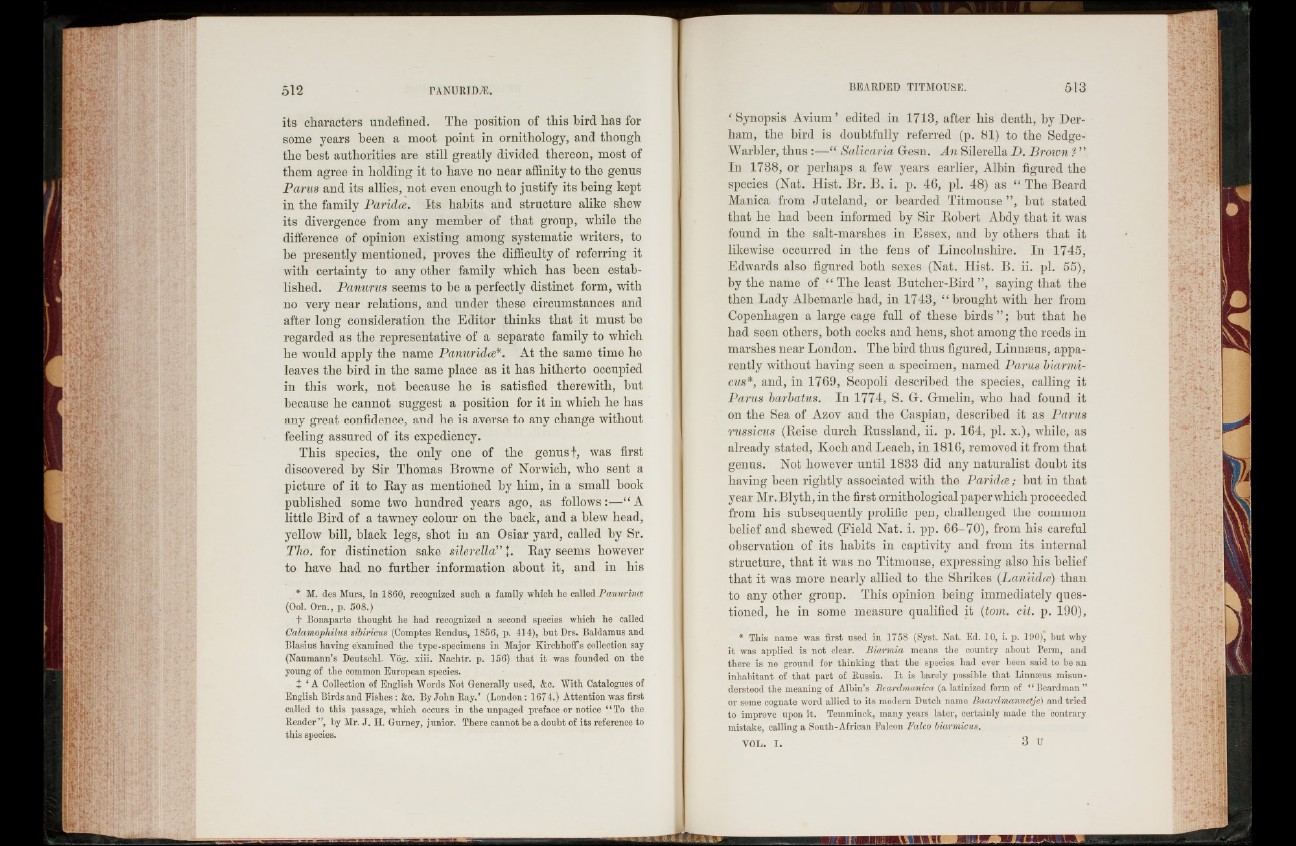
its characters undefined. The position of this hird has for
some years been a moot point in ornithology, and though
the best authorities are still greatly divided thereon, most of
them agree in holding it to have no near affinity to the genus
Parus and its allies, not even enough to justify its being kept
in the family Paridce. Its habits and structure alike shew
its divergence from any member of that group, while the
difference of opinion existing among systematic writers, to
he presently mentioned, proves the difficulty of referring it
with certainty to any other family which has been established.
Panurus seems to be a perfectly distinct form, with
110 very near relations, and under these circumstances and
after long consideration the Editor thinks that it must he
regarded as the representative of a separate family to which
he would apply the name Panuriclce*. At the same time he
leaves the bird in the same place as it has hitherto occupied
in this work, not because he is satisfied therewith, hut
because he cannot suggest a position for it in which he has
any great confidence, and he is averse to any change without
feeling assured of its expediency.
This species, the only one of the genus f, was first
discovered by Sir Thomas Browne of Norwich, who sent a
picture of it to Ray as mentiofied by him, in a small hook
published some two hundred years ago, as follows:—“ A
little Bird of a tawney colour on the hack, and a blew head,
yellow hill, black legs, shot in an Osiar yard, called by Sr.
Tho. for distinction sake silerella” t. Ray seems however
to have had no further information about it, and in his
* M. des Murs, in 1860, recognized such a family which he called Panurince
(Ool. Orn., p. 508.)
T Bonaparte thought he had recognized a second species which he called
Calamophilus sibiricus (Comptes Rendus, 1856, p. 414), but Drs. Baldamus and
Blasius having examined the type-specimens in Major Kirchhoff s collection say
(Naumann’s Deutschl. Yog. xiii. Nachtr. p. 156) that it was founded on the
young of the common European species.
$ 1 A Collection of English Words Not Generally used, &c. With Catalogues of
English Birds and Fishes : &c. By John Ray.’ (London: 1674.) Attention was first
called to this passage, which occurs in the unpaged preface or notice *1 To the
Reader”, by Mr. J. H. Gurney, junior. There cannot be a doubt of its reference to
this species.
‘ Synopsis Avium’ edited in 1713, after his death, by Der-
ham, the bird is doubtfully referred (p. 81) to the Sedge-
Warbler, thus Salicaria Gresn. An Silerella D. Brown ? ”
In 1738, or perhaps a few years earlier, Albin figured the
species (Nat. Hist. Br. B. i. p. 46, pi. 48) as “ The Beard
Manica from Juteland, or bearded Titmouse ”, but stated
that he had been informed by Sir Robert Abdy that it was
found in the salt-marshes in Essex, and by others that it
likewise occurred in the fens of Lincolnshire. In 1745,
Edwards also figured both sexes (Nat. Hist. B. ii. pi. 55),
by the name of “ The least Butcher-Bird ” , saying that the
then Lady Albemarle had, in 1743, “ brought with her from
Copenhagen a large cage full of these b ird s” ; but that he
had seen others, both cocks and hens, shot among the reeds in
marshes near London. The bird thus figured, Linnaeus, apparently
without having seen a specimen, named Parus biarmi-
cus*, and, in 1769, Scopoli described the species, calling it
Parus barbatus. In 1774, S. Gf. Gmelin, who had found it
on the Sea of Azov and the Caspian, described it as Parus
russicus (Reise durch Russland, ii. p. 164, pi. x.), while, as
already stated, Koch and Leach, in 1816, removed it from that
genus. Not however until 1833 did any naturalist doubt its
having been rightly associated with the Paridce; but in that
year Mr. Blyth, in the first ornithological paper which proceeded
from his subsequently prolific pen, challenged the common
belief and shewed (Field Nat. i. pp. 66-70), from his careful
observation of its habits in captivity and from its internal
structure, that it was no Titmouse, expressing also his belief
that it was more nearly allied to the Shrikes (Laniidce) than
to any other group. This opinion being immediately questioned,
he in some measure qualified it (tom. cit. p. 190),
* This name was first nsed in 1758 (Syst. Nat. Ed. 10, i. p. 190), but why
it was applied is not clear. Biarmia means the country about Perm, and
there is no ground for thinking that the species had ever been said to be an
inhabitant of that part of Russia. I t is barely possible that Linnseus misunderstood
the meaning of Albin’s Beardmanica (a latinized form of “ Beardman”
or some cognate word allied to its modern Dutch name Baardmannetje) and tried
to improve upon it. Temminck, many years later, certainly made the contrary
mistake, calling a South-African Falcon Falco biarmicus.
VOL. I . 3 U